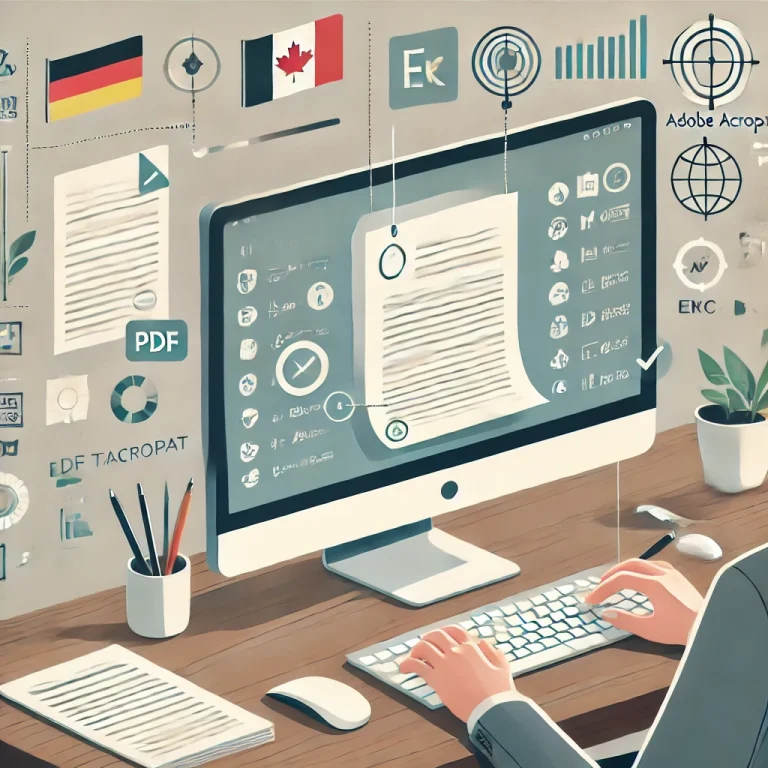PDF translation involves converting the text and formatting of a PDF document from one language to another while maintaining the original structure, visuals, and layout. This process is essential for businesses and legal professionals who need to share accurate and localized content with a global audience. Whether you’re translating a business report or a legal contract, doing so professionally ensures clarity, precision, and legal compliance.
Why is Professional PDF Translation Important?
Professional PDF translation ensures that both the content and structure of the document remain intact during the translation process. Unlike simple text documents, PDFs include fixed layouts, images, and complex formatting that must be preserved. This is particularly important for:
- Legal Contracts: Any mistranslation can lead to serious legal ramifications.
- Marketing Materials: Maintaining brand integrity across languages is essential for global outreach.
- Technical Manuals: Precision is key to ensuring users understand complex instructions.
Types of PDF Documents for Translation
Understanding the type of document you need to translate helps determine the right approach.
Translating Legal Contracts
Legal contracts require highly accurate translations due to their binding nature. A small mistake can lead to significant legal consequences. Therefore, it’s crucial to work with certified translators who specialize in legal terminology.
Business Reports
Translating business reports demands accuracy in both the language and the financial or business terminology used. Ensuring that the data and figures remain unaltered during the translation process is essential.
Marketing Materials
For marketing materials, translators must not only convey the message but also adapt it to the target audience’s culture. This is where localization comes in—adjusting the content to resonate with the cultural nuances of the new audience.
Learn more how to Certify Translation for Legal Documents by clicking here.
Challenges in Translating PDF Files
Translating PDF files isn’t always straightforward due to various technical and linguistic challenges:
Preserving Layout and Formatting
One of the biggest challenges is maintaining the original layout of the document. PDF documents are formatted to be visually consistent across devices, but translating the content may disrupt this formatting.
Handling Complex Graphics
Images, graphs, and tables within a PDF file often contain text that needs to be translated without altering the visual structure. Special care must be taken when reformatting such files.
Language-Specific Challenges
Some languages, such as Arabic, present unique challenges due to their right-to-left script. Reformatting these languages in a PDF can be more complex than in left-to-right languages like English.
Step-by-Step Guide to Translating PDF Documents
Preparing the Document for Translation
Start by reviewing the PDF file and identifying the type of content it contains (text, images, tables, etc.). This will help determine the tools and methods needed for extraction and translation.
Extracting Text from the PDF
Using PDF editing tools like Adobe Acrobat or online tools, extract the text content from the PDF. Make sure the extracted text retains its structure.
Translating the Extracted Text
Once the text is extracted, use a professional translation service or software, ensuring you retain the meaning and tone of the original document.
Reintegrating the Translation into the PDF
After translation, the next challenge is to reinsert the text into the PDF while maintaining the layout. This can be done manually or using specialized software.
Verifying Formatting Consistency
Before finalizing the document, double-check that the translated text fits within the original design, images, and tables.
Tools for Translating PDF Files Professionally
Machine Translation Tools
Machine translation tools like Google Translate and DeepL can help with initial translations, but they are often unsuitable for professional-level translations where accuracy and context are critical.
Computer-Assisted Translation (CAT) Tools
CAT tools such as SDL Trados and MemoQ offer more robust solutions for professional translators, helping maintain consistency across large documents and offering real-time translation memory.
PDF Editors for Reformatting
Adobe Acrobat and tools like Inkscape are invaluable for preserving the format and reinserting translated text into the original PDF layout.
Translating PDF Files into Arabic
Translating PDF files into Arabic presents unique challenges due to the language’s script and cultural nuances.
Cultural and Linguistic Considerations
Arabic is a rich and diverse language, and professional translators must ensure that the translation fits the cultural context of the intended audience.
Tools Supporting Arabic PDF Translation
Some translation tools offer better support for Arabic, ensuring that the right-to-left formatting is maintained throughout the document.
Maintaining Right-to-Left Layout in PDFs
One of the biggest challenges in Arabic translation is maintaining the right-to-left layout in PDFs. This often requires specialized software to ensure that the translated text flows correctly.
Translating Legal Contracts: Key Considerations
When translating legal contracts, accuracy is critical. Any mistranslation can lead to legal disputes.
Accuracy and Legal Compliance
Legal translators must have expertise in the specific legal system they are working with to ensure compliance with local laws and terminology.
Maintaining Confidentiality and Data Protection
Working with sensitive legal documents requires strict confidentiality and data protection protocols.
Working with Certified Translators
It’s essential to work with certified translators for legal documents to ensure credibility and reliability.
Best Practices for Professional PDF Translation
Proofreading and Quality Assurance
Ensure that the translated document is thoroughly proofread to catch any errors and ensure that the translation is both accurate and fluid.
Client Communication and Feedback
Maintaining clear communication with clients helps avoid misunderstandings and ensures that the final product meets their expectations.
Formatting and Visual Consistency
Professional PDF translation involves not just linguistic translation but also ensuring that the document’s visual integrity is maintained.
How to Translate PDFs for Multiple Languages
Localization versus Translation
Localization goes beyond simple translation by adapting the content to fit the target culture, making the document more relatable to the audience.
Managing Multilingual Projects
For large multilingual projects, a well-structured workflow and the use of translation memory can streamline the process and ensure consistency across languages.
Voice Search and AI-Friendly Strategies for PDF Translation
Using Natural Language for Voice Search
With the rise of voice search, it’s essential to optimize PDF translation services for natural language queries. Use conversational language and keywords that people are likely to use in voice commands.
Optimizing Translation Services for AI-based Search Engines
Ensure your translation services are AI-friendly by using structured data, natural language processing (NLP) techniques, and optimizing for local search queries.
How to Choose a Professional PDF Translation Service
Evaluating Translation Quality
Before choosing a service, evaluate their portfolio and reviews to ensure high-quality translations that preserve both content and format.
Comparing Pricing Models
Look for a service that offers transparent pricing based on the complexity and length of the document.
Client Reviews and Testimonials
Client reviews provide insight into the reliability and quality of a translation service. Be sure to research thoroughly before committing.
Common FAQs on PDF Translation
Can I translate a PDF file myself?
Yes, but professional services are recommended for accuracy and maintaining formatting.
What tools can I use to translate PDFs?
You can use Adobe Acrobat for formatting and machine translation tools like DeepL for initial drafts.
How do I translate a legal contract PDF?
Work with certified translators who specialize in legal terminology.
Is translating PDF files into Arabic difficult?
It can be challenging due to the right-to-left text format, but professional tools can help.
Do machine translation tools work for PDF translation?
While they can help with basic translations, they are not suitable for professional use.
How do I ensure the translated PDF maintains its original format?
Use specialized PDF editors and ensure the layout is reviewed after the translation process.
Conclusion and Final Tips on Professional PDF Translation
Translating PDF documents professionally requires not just linguistic skills but also an understanding of the technical challenges that come with maintaining formatting and layout. By following the steps outlined in this guide and using the right tools, you can ensure your PDF translations are accurate, culturally appropriate, and professionally formatted.


